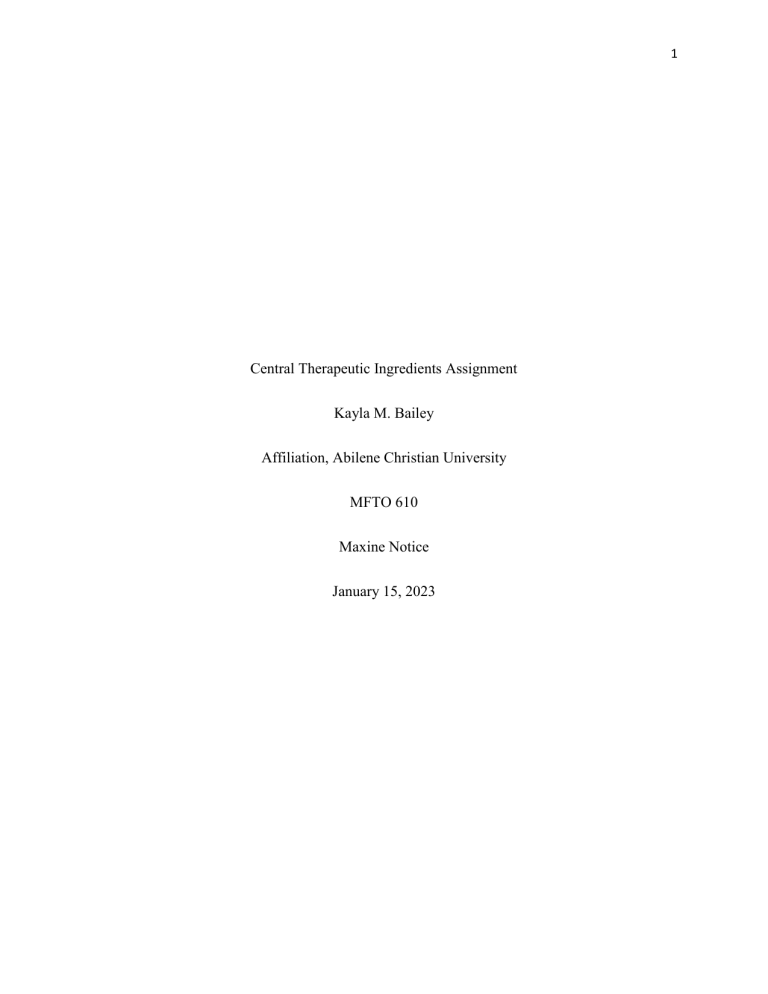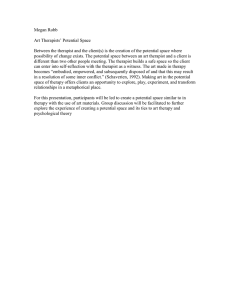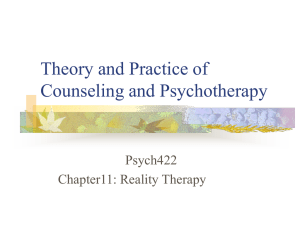
1 Central Therapeutic Ingredients Assignment Kayla M. Bailey Affiliation, Abilene Christian University MFTO 610 Maxine Notice January 15, 2023 2 Central Therapeutic Ingredients Assignment The therapeutic relationship describes the working relationship between the client and therapist. The relationship can be described as a mutually respected one. For the working relationship to be a positive experience for both therapist and client, there needs to be a strong foundation. With this foundation, the relationship will be trusting and respected. The therapist and the client have their jobs, for lack of a better word, within their relationship. While neither person's job is more important, they coincide and must coexist without judgments or biases. To begin a therapeutic relationship, the therapist must present themselves in a specific manner that appeases the client and their needs. The therapist should, naturally, present themselves with specific interpersonal skills that will help the client form a bond. These skills will also assist the therapist in helping the client more efficiently and positively. The central therapeutic ingredients described are warmth, genuineness, and empathy. These are necessary for the therapeutic relationship to continue due to distrust, lack of respect, and honesty. First, warmth is the therapists' ability to communicate efficiently with clients by showing that they are positive, caring, considerate, and concerned for their well-being. Using this skill, the therapist can reach the client on a level that creates trust and a foundation for positivity. There is a "genuine respect for human beings" when demonstrating this skill. (Truax & Carkhuff, 1976, p. 35) Warmth shows the client that the therapist is nonjudgmental and is there to help find a solution rather than condemn them. Secondly, empathy is the therapists' ability to understand their clients. Therapists can put themselves in their client's shoes and are sensitive to their feelings. Empathy is the "working force of any helping relationship." (Truax & Carkhuff, 1976, p. 39) Empathy will promote growth within the client and help them recognize their feelings. 3 However, both warmth and empathy need to be genuine. Posing or faking an interpersonal skill could cause the client to distrust the therapist or feel their feelings are not validated. Finally, genuineness is the person's realness through honesty, acceptance, concern, reaction, and response. Demonstrating artificial skills can "interfere with the therapeutic effectiveness." (Truax & Carkhuff, 1976, p. 34) The client needs a therapist who can place them as real people going through real problems. Think authenticity. Therapist request that their clients are open and honest with them; therefore, they need to reciprocate that to their clients as well. In my opinion, genuineness is the most essential central therapeutic ingredient of the therapeutic relationship. As humans, we often worry about what others think of us when sharing personal details about ourselves. With genuineness, therapists are authentic in their responses and who they are. They treat their clients like a real person and can begin building trust. Demonstrating genuineness is a way to show that the client is not just "another case." As described in Truax and Carkhuff's text, one cannot fake genuineness or offer another skill in its place. While genuineness is involved in all human relationships, it is also a complex skill to demonstrate. However, without it, we cannot accept all of ourselves as we truly are. Therapists are able to show that they are accepting of their clients and their problems by creating a safe space for progression. Part of the therapist’s job is to ensure that the client has a safe space to discuss topics or conversations that are hard for them. Safety entails that the therapist will do no harm to the client and will ensure that pressure and judgment are left out of the session. Clients are reluctant to share specific details if they feel the therapist will not provide a safe space. This does not mean that the therapist will not be mandated to report specific issues. However, it is a space for the client to discuss with the therapist openly. The client should begin to feel comfortable with their 4 therapist and build the foundation for their sessions. For example, a child who feels safe with their therapist may openly communicate that they are being physically abused at home by a family member. Safety is creating a trusting foundation between the client and the therapist. Also, the therapist must ensure they accept, not necessarily approve, the client’s problems and work towards a common goal. With acceptance, the client will gain the courage to face their issues with a supportive and positive figure. For example, a mother may indicate to the therapist that they are involved in a CPS case due to methamphetamine usage while caring for their child. While the therapist may not condone the mother’s actions, they accept them and help resolve them. I imagine navigating safety is much easier than navigating acceptance. We can create safe spaces; however, as humans, it is hard not to place judgment upon others, even the slightest. We often think, “I could never do that,” or “why would someone do that.” One thing that we can do is work on changing our mindsets. A difference in our attitude can help us place ourselves in another person’s shoes and help us help those we are trying to help. In conclusion, the therapeutic relationship is much like any other human interaction. As humans, we strive to be the best version of ourselves. We want to be genuine, authentic, trusting, warm, and nonjudgmental. When speaking to others about personal problems, we find the person who makes us feel safe and often accepts us regardless of our obstacles. There is no difference in the therapeutic relationship. However, we must focus on being fully authentic with our responses, reactions, and concerns rather than fake them for additional information. 5 References Truax, C. B., & Carkhuff, R. (1976). Central therapeutic ingredients: Theoretic convergence [Review of Central Therapeutic Ingredients: Theoretic Convergence]. Toward Effective Counseling and Psychotherapy: Training and Practice, 23–79.

